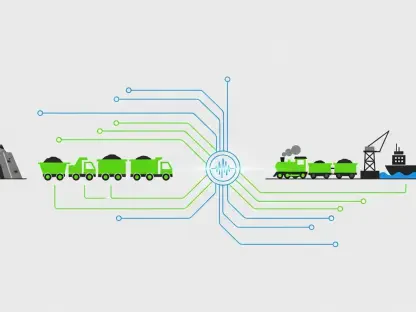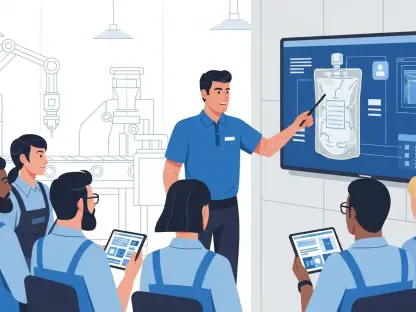Transforming the landscape of human resources (HR) through technology has become pivotal in today’s dynamic business environment. With advancements such as artificial intelligence (AI), HR leaders must adopt a strategic approach to leverage these tools effectively. The primary focus rests on aligning technology with business goals, improving workforce management, and preparing employees for the future. The integration of innovative technology in HR practices enhances the overall efficiency and productivity of an organization, setting the stage for sustainable growth and adaptability.
Developing a Clear Technology Strategy
The Roadmap for HR Technology
Michael Doolin, CEO of Clover HR, emphasizes the necessity of creating a well-defined technology strategy. This roadmap should evaluate current workforce skills while predicting future needs. Importantly, such a strategy must be in line with the company’s growth ambitions, both domestically and internationally. The technology roadmap needs to account for specific business goals that align with the overall strategic objectives of the organization. Developing a comprehensive strategy requires meticulous planning and foresight, assessing the current technological landscape, and anticipating future advancements.
Doolin argues that integrating technology into HR processes should not be seen as an isolated initiative but as a core component of the business strategy. Effective use of HR technology facilitates better decision-making, enhances employee productivity, and ensures the organization remains competitive in a constantly evolving market. By focusing on creating a clear technology strategy, HR leaders can bridge the gap between present capabilities and future requirements, fostering organizational alignment and driving meaningful outcomes. Such an approach ensures that technology investments translate into tangible improvements in workforce management and business performance.
Balancing Technology and Human Touch
Doolin argues that technology must act as an enabler rather than the sole driving force. While it should enhance efficiency and decision-making, the emphasis must remain on sustainable growth. Critical to this approach is the balance between technological advancements and adaptability. Technology should complement and augment human capabilities, rather than replace them, ensuring that employees remain at the heart of HR initiatives. A balanced approach ensures that technological solutions integrate seamlessly with human interactions, fostering a collaborative and inclusive work environment.
Integrating technology into HR processes involves automating repetitive and time-consuming tasks, allowing HR professionals to focus on more strategic and value-added activities. By leveraging technology, HR departments can streamline processes such as recruitment, onboarding, performance management, and employee engagement, ultimately enhancing the overall employee experience. However, the human touch remains essential in areas requiring empathy, creativity, and emotional intelligence. Doolin stresses the importance of maintaining a human-centric approach, ensuring that technology serves as a tool to empower employees and HR professionals alike.
Adapting to a Dynamic Workplace
Generational Shifts and HR Technology
April Whitson from ABB Process Industries stresses that HR technology should continuously evolve to meet the demands of a changing workplace. A significant challenge involves integrating Gen Z talent into traditional industries, breaking down outdated preconceptions, and utilizing technology to track engagement and skillsets. The arrival of Gen Z in the workforce brings fresh perspectives and expectations, necessitating a shift in how organizations manage and engage their employees. Technology plays a crucial role in facilitating this transition by providing insights into emerging skill sets and tracking engagement trends.
Whitson highlights that traditional industries can benefit from embracing innovative HR technology to attract, retain, and develop Gen Z talent. By leveraging data-driven insights, organizations can identify the unique strengths and preferences of this generation, tailoring their HR strategies accordingly. Implementing cutting-edge technology solutions not only enhances the overall employee experience but also fosters a culture of continuous learning and development. This approach ensures that organizations remain agile and adaptable in the face of generational shifts, ultimately driving long-term success.
Empowering Leaders with Tools and Insights
Whitson also underscores the imperative of equipping leaders with the right tools and insights. By doing so, HR can drive meaningful change and adapt to ever-shifting workforce expectations, ensuring technology serves the broader organizational goals. Providing leaders with access to real-time data and analytics enables them to make informed decisions and respond proactively to emerging trends and challenges. Empowered leaders can create a supportive and inclusive work environment, fostering a culture of continuous improvement and innovation.
Equipping leaders with the right tools and insights enhances their ability to manage diverse teams, address employee concerns, and drive performance. HR technology enables leaders to track key performance indicators, monitor employee engagement, and identify areas for improvement. This data-driven approach facilitates targeted interventions and personalized development plans, ensuring that employees receive the support and resources they need to thrive. By empowering leaders with the right tools and insights, organizations can create a culture of accountability, transparency, and collaboration, ultimately driving sustainable growth and success.
The Role of AI in HR
Enhancing Efficiency with AI
Sirsha Haldar from ADP points out that AI is transforming HR by making hiring processes more efficient and optimizing workforce management. However, the successful implementation of AI requires rigorous oversight, ensuring alignment with company values and regulations. AI-driven tools can streamline recruitment processes by automating candidate screening, enhancing the quality of hires, and reducing time-to-hire. Additionally, AI can analyze vast amounts of data to identify patterns and trends, enabling HR professionals to make data-driven decisions and improve workforce management strategies.
Haldar emphasizes that while AI offers significant potential to enhance efficiency, its implementation must be guided by ethical considerations and regulatory compliance. Organizations must ensure that AI-driven processes are transparent, fair, and unbiased. Continuous monitoring and refinement are essential to maintain the integrity and effectiveness of AI tools. By adhering to ethical standards and regulatory requirements, organizations can harness the benefits of AI while safeguarding against unintended consequences. This balanced approach ensures that AI serves as a valuable tool for HR professionals, driving innovation and improving overall business performance.
Ethical Considerations and Security
Haldar highlights the need for continuous monitoring and ethical considerations in AI tools. Implementing sophisticated security protocols is crucial to prevent unauthorized access, data breaches, and intellectual property risks, maintaining user trust and adhering to privacy regulations. As AI systems process vast amounts of sensitive data, ensuring the security and privacy of this information is paramount. Organizations must adopt robust security measures to protect sensitive employee data from potential cyber threats and breaches.
Ethical considerations are equally important in the implementation of AI-driven HR processes. Organizations must ensure that AI tools are designed and deployed in a manner that respects employee privacy, promotes fairness, and aligns with company values. Regular audits and evaluations are necessary to identify and address any biases or ethical concerns that may arise. By maintaining a strong ethical and security framework, organizations can build trust with employees and stakeholders, ensuring the responsible and effective use of AI in HR.
Focusing on the Human Experience
People-Centric Technology Strategy
Tia Millar, chief product officer at Safeguard Global, emphasizes the human element in HR technology. The goal is to streamline processes while allowing for meaningful human interactions. Regularly reviewing the technology strategy ensures it stays relevant and effective. A people-centric approach prioritizes the well-being and development of employees, recognizing that technology should serve to enhance, rather than replace, human connections. By focusing on the human experience, organizations can create a positive and engaging work environment.
Millar advocates for a technology strategy that balances automation with opportunities for meaningful human interactions. Streamlining administrative tasks through technology allows HR professionals to dedicate more time to activities that promote employee engagement, well-being, and development. Regular reviews of the technology strategy ensure that it remains aligned with organizational goals and evolving workforce needs. This iterative approach enables organizations to adapt to changing circumstances and continuously improve the employee experience.
Adapting to the Evolving Role of Technology
Millar’s insights include the necessity for HR to reimagine training and development strategies. As AI takes over repetitive tasks, employees will need new skills to work alongside these tools. This shift is an opportunity for HR to play a strategic role in upskilling and reskilling the workforce for future challenges. By identifying emerging skill sets and providing targeted training programs, organizations can ensure that their employees remain competitive and capable in a rapidly changing technological landscape.
The evolving role of technology necessitates a proactive approach to employee development. HR departments must anticipate future skills requirements and design training programs that equip employees with the competencies needed to thrive in a technology-driven environment. This includes not only technical skills but also soft skills such as critical thinking, creativity, and collaboration. By fostering a culture of continuous learning and development, organizations can create a resilient and adaptable workforce capable of navigating the challenges and opportunities presented by technological advancements.
Agility in HR Strategy
Continuously Adapting to Changing Conditions
Michael Doolin notes the critical need for HR to remain agile, ready to adapt to shifting business priorities and external factors. Continuous evaluation of strategies ensures that HR remains effective in a rapidly changing business landscape. Agility in HR strategy involves regularly assessing and adjusting processes, policies, and programs to align with evolving organizational goals and market conditions. This dynamic approach enables HR departments to respond swiftly to emerging trends and challenges, ensuring sustained organizational success.
Doolin emphasizes that maintaining agility requires a proactive mindset and a willingness to embrace change. HR leaders must stay informed about industry developments, technological advancements, and shifting workforce expectations. By fostering a culture of agility and adaptability, organizations can navigate uncertainties and capitalize on new opportunities. Continuous evaluation and refinement of HR strategies ensure that they remain relevant and effective, driving organizational resilience and long-term success.
Preparing for the Future of Work
Transforming the human resources landscape with technology has become crucial in today’s fast-paced business world. Technological advancements, particularly artificial intelligence (AI), demand that HR leaders adopt a strategic mindset to utilize these tools successfully. The main objective is to harmonize technology with business objectives, enhancing workforce management, and equipping employees for future challenges. Incorporating innovative technology into HR practices boosts the overall efficiency and productivity of organizations, paving the way for sustainable growth and adaptability. Beyond just streamlining processes, technology in HR also enables data-driven decision-making, fosters better communication, and refines recruitment strategies. As the workforce evolves, HR departments must continuously adapt their technological approaches to address emerging trends and needs, ensuring they remain ahead in the competitive landscape. Embracing this digital transformation is not just an option but a necessity for forward-thinking companies aiming for long-term success and resilience.









